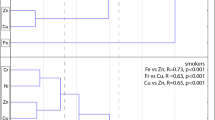Abstract
Forty-nine refinery workers and 50 motor mechanics were selected and examined for total lead (PbT), inorganic lead (PbI), and δ-aminolevulinic acid (ALA) in urine. The worker groups were exposed to tetraethyl lead (TEL) mainly by inhalation, but motor mechanics received additional exposure by skin because of hand cleansing with gasoline.
The levels of urinary ALA (ALA-U) and urinary PbT (PbT-U) in refinery workers and motor mechanics were found to be significantly higher than the control group (p<0.05). The correlation between the ALA-U and PbT-U was found significant in both worker groups (p<0.001); however, relatively higher positive correlation was found between ALA-U and urinary inorganic lead (PbI-U) in TEL-exposed workers.
Similar content being viewed by others
References
E. Caplun, D. Petit, and E. Picciotto, Lead in petrol,Endeavour 8(3), 135–144 (1984).
C. M. Shy, Lead in petrol: the mistake of the XXth century,World Health Statist. Quart. 43, 168–176 (1990).
TÜPRAS Annual report (1994).
N. Vural, and G. Güvendik, Blood lead and cadmium levels of the population leaving in Ankara.Vet. Hum. Toxicol. 29, 127–128 (1987).
N. Vural, and G. Güvendik, Blood lead level distribution by age group in inhabitants of Ankara,Biol. Trace Element Res. 18, 85–93 (1988).
R. W. Baloh, Laboratory diagnosis of increased lead absorbtion,Arch. Environ. Health 28, 198–208 (1974).
L. Alessio, A. Berlin, M. Boni, and R. Roi,Biological Indicators for the Assessment of Human Exposure to Industrial Chemicals, Commission of the European Communities Joint Research Center Ispra Establishment, Ispra, Varese (1987).
R. Selander and K. Cramer, Interrelationships between lead in blood, lead in urine and ALA in urine during lead work,Br. J. Ind. Med. 27, 28–39 (1970).
R. Lauwerys, J. P. Buchet, H. A. Roels, and M. D. Materne, Relationship between urinary δ-aminolevulinic acid excretion and the inhibition of red cell δ-aminolevulinate dehidratase by lead,Clin. Toxicol. 7(4), 383–388 (1974).
C. B. Burns and I. R. Godwin, A comparison of the effects of inorganic and alkyl lead compounds on human erythrocytic delta-aminolevulinic acid dehydratase (ALAD) activity in vitro,J. Appl. Toxicol. 11(2), 103–110 (1991).
H. Siegel and A. Siegel, Metal ions in biological systems, inBiological Properties of Metal Alkyl Derivatives, Vol. 29, Marcel Dekker, New York, pp. 137–160 (1993).
A. Karakaya and A. Taylor, On-line pre-concentration for the measurement of cadmium in urine by flame atomic absorption spectrometry,J. Anal. Atomic Spectrom. 4, 261–263 (1989).
F. Arai, Determination of triethyllead, diethyllead and inorganic lead in urine by atomic absorption spectrometry,Ind. Health 24, 139–150 (1986).
T. Tomokuni, and M. Ogata, Simple method for determination of δ-aminolevulinic acid as an index of lead exposure,Clin. Chem.,18, 1534–1536 (1972).
A. Trevisan, Concentration adjustment of spot samples in analysis of urinary xenobiotic metabolites,Am. J. Ind. Med. 17, 637–642 (1990).
R. C. Baselt,Biological Monitoring Methods for Industrial Chemicals California Biomedical Publications, Davis, CA (1980).
N. Vural and Y. Duydu, Biological monitoring of lead in workers exposed to tetraethyl lead,Sci. Total Environ. 171, 183–187 (1995).
A. J. Fleming, Industrial hygiene and medical control procedures,Arch. Environ. Health 8, 266–268 (1964).
R. A. Kehoe, Lead, alkyl compounds, inOccupational Health and Safety, International Labour Organization (ILO), Geneva (1983).
P. Grandjean and T. Nielsen, Organolead compounds: environmental health aspects,Residue Rev. 72, 97–148 (1979).
Z. Turlakiewicz and J. Chmielnicka, Diethyllead as a specific indicator of occupational exposure to tetraethyllead,Br. J. Ind. Med. 42, 682–685 (1985).
W. Zhang, G. G. Zhang, H. Z. He, and H. M. Bolt, Early health effects and biological monitoring in persons occupationally exposed to tetraethyllead,Int. Arch. Occup. Environ. Health 65, 395–399 (1994).
D. E. Pryde, Is it appropriate to adjust the results of urine analyses for concentration-dilution effects? International Workshop on Biological Indicators of Cadmium Exposure. Diagnostic and Analytical Reiability. CEC-IUPAC, July 7–9 (1982).
T. R. Robinson, Delta-aminolevulinic acid and lead in urine of lead antiknock workers,Arch. Environ. Health. 28, 133–138 (1974).
M. Hirata, T. Yoshida, K. Miyajima, H. Kosaka, and T. Tabuchi, Correlation between lead in plasma and other indicators of lead exposure among lead-exposed workers,Int. Arch. Occup. Environ. Health 68, 58–63 (1995).
T. Sakai and Y. Morita, “-Aminolevulinic acid in plasma or whole blood as a sensitive indicator of lead effects, and its relation to the other heme-related parameters,Int. Arch. Occup. Environ. Health 68, 126–132 (1996).
Author information
Authors and Affiliations
Rights and permissions
About this article
Cite this article
Duydu, Y., Vural, N. Urinary excretion of lead and δ-aminolevulinic acid in workers occupationally exposed to tetraethyl lead. Biol Trace Elem Res 63, 185–194 (1998). https://doi.org/10.1007/BF02778936
Received:
Revised:
Accepted:
Issue Date:
DOI: https://doi.org/10.1007/BF02778936




